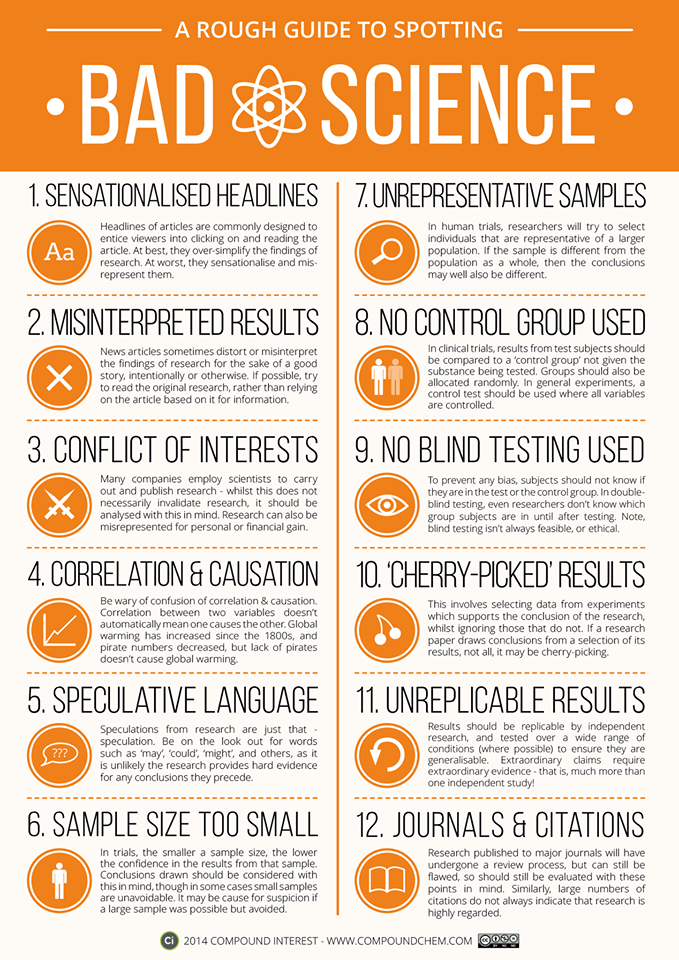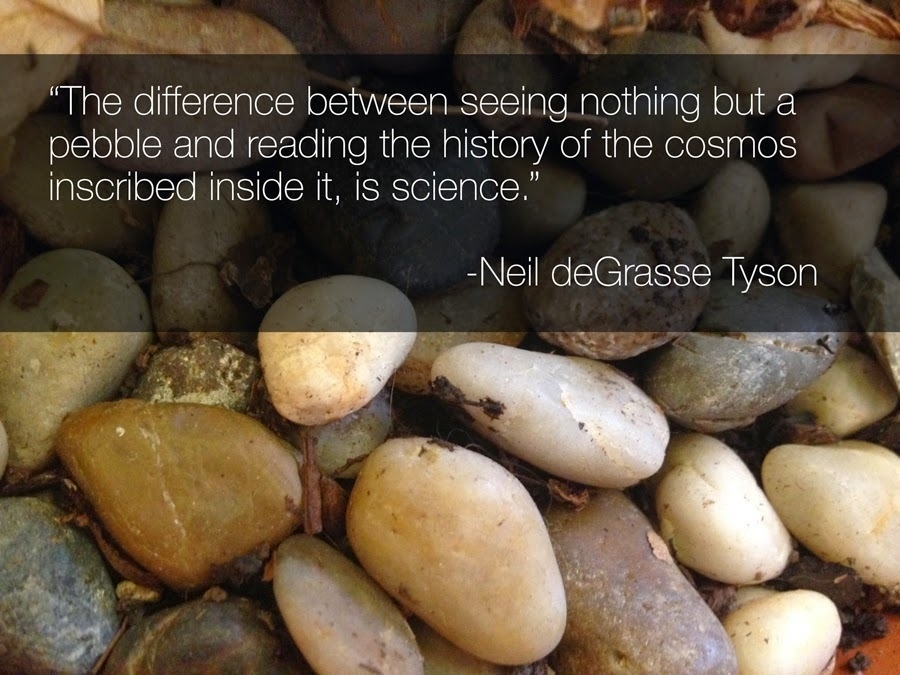Science
Understanding the eclipse by creating a to-scale demonstration of orbits and moon phases
I was recently asked to do a presentation about the upcoming solar eclipse at our library as I am one of a small local group of amateur astronomers. I happily accepted. I always enjoy putting together Keynote presentations for such events. I spent several days last week assembling the 38 slide presentation and did the presentation last night. It seemed to go well. For one part of the presentation I used three volunteers to serve as the sun, moon, and Earth. The idea was to illustrate the phases of the moon as well as the angle of the moon’s orbit with these three people and in truth, after a bit of initial confusion, I think it went pretty well. But it wasn’t to scale as we were crowded into a fairly small room at the library. After the event I got to thinking about how that sort of presentation, in particular the bit involving the volunteers, could be expanded into something really fun but in an outside location so that a sense of scale could be created. It would involve a bit of math so I thought it might be fun to recruit Siri as my helper in preparing this activity.
The idea would be to create a scale model of the Earth in relation to the sun and moon based on a circle of 365 feet in circumference. Each foot represented one day in the Earth’s orbit around the sun. Now, at this scale, I wanted to properly represent the position the sun at the center of our orbit. I needed the radius of my circle. Okay. I asked Siri to calculate the radius of a circle with a circumference of 365 feet. I was given a WolframAlpha calculation screen as a result: 58.1 feet. But I wondered if I could copy/paste the content. It had never occurred to me to tap the WolframAlpha icon, just a bit of text in a square in the corner of that display of results. I’ve done this kind of thing many times but never thought to see what would happen if I tapped. I expected it would do nothing. Instead, it took me to the AppStore for the WolframAlpha app. It never occurred to me that there was such an app but of course there is! I downloaded it and it opened my results into the app. It’s a very nice app that allows further input and new calculations among many other things. But no option to copy/paste the content.
Now, back to working out the activity. I’ll need to get some string but before that, I now know that if my orbit is scaled to 365, feet my radius is 58.1 feet. So, I’ll position my sun with a pole with string tied to it. From there I’ll walk out 58.1 feet and place another pole. I’ll have two strings. One which I’ll keep tied to the center pole (my sun) and which will guide my “orbit”. The second string will be tied to the second pole. Now it’s just a matter of walking the circle around the sun and dropping my string to represent the 365 feet of orbit. The next step is to convert a few other distances. For this I hopped over to this solar system scale model calculator.
Next, I used Siri to do a bit of math. First I asked her for the average circumference of the Earth’s orbit. Then I asked her to convert this from miles into feet. Then I divided that by 365 come up with my model scale of 8,447,618,973. With that number input into the solar system scale calculator I confirmed my Earth orbit radius of 58.1 in the results. Next, I wanted to get the moon’s orbit as well as the size of my three solar system objects at this scale. I made sure to select the Moons option and on the form and I got an orbit radius for the moon of 1.79 inches. TINY!! With that radius the average circumference of the lunar orbit is just 11.25 inches. Whats’ the size of the sun, Earth and moon at this scale? According to this same calculator, at this scale the sun is just 6.49 inches in diameter. Of course, the Earth and moon are very tiny! The Earth is just .06 inches in diameter and the moon is .016. Just a spec.
So, I’ve got the scale though in truth it might be best done at a slightly larger scale given how tiny the Earth and moon are in this model. Regardless of the ultimate scale of the model it is fun to play with and I expect it will be a fun model to explore in the yard. The idea would be to set the scale and then discuss the movement of the moon in it’s orbit of the Earth and the Earth’s orbit around the sun. By positioning volunteers it becomes a bit more obvious why a new moon is invisible to us. By adjusting the position of the volunteer “moon” in orbit around the volunteer “Earth” it become easier to understand how the moon gradually becomes more visible as a crescent then a quarter then a full moon and so on. Further discussion of the 5° elevation of the moon off of the ecliptic helps participants further understand why we do not have solar eclipses with every new moon.
Jupiter in an amazing fly-by video
Jupiter is immense. The fifth planet from the sun has a diameter of 89,000 miles, and could easily envelop every other planet (and Pluto). The gas giant also has 2.5 times the mass of all those planets combined. Even its enormous storms boggle the mind: the Great Red Spot is big enough to contain the Earth.Photos provide glimpses of Jupiter’s grandeur, but you can’t appreciate its stunning scale without some perspective. Gerald Eichstaedt and Seán Doran provide some with a stunning flyby video made from dozens of still photographs taken by the Juno probe.
This post over at Information is Beautiful is excellent: Mavericks & Heretics.
It’s 2017 and the struggle between reason and religion continues.
Barack Obama: America will take the giant leap to Mars
One of my earliest memories is sitting on my grandfather's shoulders, waving a flag as our astronauts returned to Hawaii. This was years before we'd set foot on the moon. Decades before we'd land a rover on Mars. A generation before photos from the International Space Station would show up in our social media feeds
I’m not a huge fan of Barack Obama (Democrats, Republicans or the two party system in general). Nor am I a fan of CNN. But I came across Obama’s essay on Mars, space exploration and STEM and well, I just can’t help myself.
Someday, I hope to hoist my own grandchildren onto my shoulders. We'll still look to the stars in wonder, as humans have since the beginning of time. But instead of eagerly awaiting the return of our intrepid explorers, we'll know that because of the choices we make now, they've gone to space not just to visit, but to stay — and in doing so, to make our lives better here on Earth.
Well said.
Apple and NASA collaborate on short film to celebrate Juno Mission: ‘Visions of Harmony’
As an avid amateur astronomer, NASA supporter and all around science nerd I was pretty happy to read today that Apple has partnered with NASA to produce a nine minute short film to celebrate the Juno spacecraft entering Jupiter’s orbit. The film is available on iTunes and Apple Music for free and is called “Visions of Harmony.” On a personal note, as is often true for many amateur astronomers, Jupiter was one of the first things I looked at with my own telescope when I was a 9th grader working on a science fair project. The view through that little telescope was breathtaking though strangely, it didn't quite seem real and it was a moment I've never forgotten.
From the NASA website:
NASA announced a collaboration with Apple that will serve to enhance the agency's efforts to inform and excite the public about dramatic missions of exploration like Juno. “Destination: Juno” is a synergy between two seemingly disparate worlds: popular music and interplanetary exploration. The works resulting from this collaboration showcase exploratory sounds from artists who have been inspired by Juno and other NASA missions, including Brad Paisley, Corinne Bailey Rae, GZA, Jim James featuring Lydia Tyrell, QUIÑ, Trent Reznor & Atticus Ross, Weezer and Zoé.
Apple has captured moments in this journey with a behind-the-scenes documentary spearheaded by the Juno mission's principal investigator, Scott Bolton, and scored by Academy Award winners Trent Reznor and Atticus Ross. The content is available on various Apple platforms. Other Juno-related content, including educational opportunities with Bill Nye on and an “Interactive Guide to NASA's Juno Mission,” will roll out over the course of a year and throughout the length of the Juno mission.
The Juno spacecraft launched on Aug. 5, 2011, from Cape Canaveral, Florida. JPL manages the Juno mission for the principal investigator, Scott Bolton, of Southwest Research Institute in San Antonio. Juno is part of NASA's New Frontiers Program, which is managed at NASA's Marshall Space Flight Center in Huntsville, Alabama, for NASA's Science Mission Directorate. Lockheed Martin Space Systems, Denver, built the spacecraft. The California Institute of Technology in Pasadena, California, manages JPL for NASA.
One thing I can say from personal experience as an amateur astronomer is that music does indeed go very well with our exploration of the Cosmos. When I go out to spend an evening at the telescope observing distant galaxies or planets in our solar system I always have a bluetooth speaker with which to play my “Stargazing” playlist. While the quiet sounds of nature are always a nice soundtrack it's usually when I have music playing that I'm most likely to have those moments which seem most otherworldly. There's nothing quite like looking through a telescope at Jupiter or something more distant such as galaxy that has been sending its combined starlight out into the universe for 12 million years. That's the kind of visual experience that is wonderfully enhanced by music.
To go along with the short film, Apple has created a new featured section on Apple Music called “Destination: Jupiter” that highlights the short film as well as the music that appears in it. I've not yet listened but it includes tracks by Trent Reznor, Corinne Bailey Rae, and Quin. The film not only includes live music by the above artists but also an interview with Juno principal investigator Scott Bolton.
NASA missions into the solar system are always exciting. Years of planning followed by years in space and then months to years of data collection. Juno, launched in August 2011, will have been traveling just shy of five years when it enters a polar orbit on July 4.
The spacecraft is to be placed in a polar orbit to study Jupiter's composition, gravity field, magnetic field, and polar magnetosphere. Juno will also search for clues about how the planet formed, including whether it has a rocky core, the amount of water present within the deep atmosphere, mass distribution, and its deep winds, which can reach speeds of 618 kilometers per hour (384 mph).
According to Apple the goal of its partnership with NASA is to educate and inspire people, while also highlighting the link between exploring space and making music. From USA Today: “The goal is to make science and technology more accessible and relatable to everyone.” - Apple vice-president Robert Kondrk.
For those that might ask, what's the connection between space exploration and creative expression? I would answer that there's nothing we might do that requires the imagination and creativity like space exploration does. Science, in a general way, is often rooted in a creative process. Much of what Einstein accomplished had it's origins in creative thought experiments in which he imagined different scenarios so that he might work through. And he isn't the only one to have used such thought experiments! Spend some time browsing around the fantastic NASA website, have a look at the many ongoing missions and past missions and consider the beautiful dance of science and creativity that goes into the designing of our space telescopes, rovers, and orbiters. NASA often exhibits the best of humanity. Okay, now I'm gushing. This is what happens when I'm allowed at the keyboard unsupervised while on the topic of NASA.
Also, in case you missed it, one last bit of NASA news. Earlier this month, NASA released an application for iOS and the fourth-gen Apple TV. The app includes live streaming NASA TV, a real-time view of the Earth from the International Space Station, as well as on-demand access to over 10,000 NASA videos and more than 15,000 photos, either individually or as a slideshow. It's a fantastic tool for exploring our solar system from the comfort of your couch. From your Apple TV search for NASA in the App Store. Or, from your iOS device get it from the iTunes App Store.
To view the new Apple Music/NASA short film, head to Apple Music.
Originally published at beardyguycreative.com on July 1, 2016.
Apple and NASA collaborate on short film to celebrate Juno Mission: ‘Visions of Harmony’
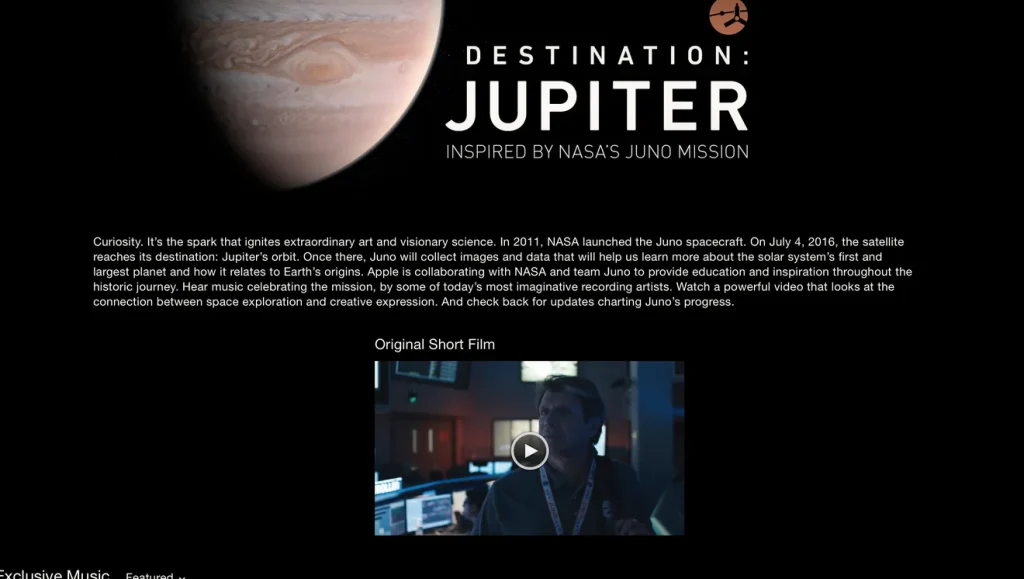
As an avid amateur astronomer, NASA supporter and all around science nerd I was pretty happy to read today that Apple has partnered with NASA to produce a nine minute short film to celebrate the Juno spacecraft entering Jupiter’s orbit. The film is available on iTunes and Apple Music for free and is called “Visions of Harmony.” On a personal note, as is often true for many amateur astronomers, Jupiter was one of the first things I looked at with my own telescope when I was a 9th grader working on a science fair project. The view through that little telescope was breathtaking though strangely, it didn’t quite seem real and it was a moment I’ve never forgotten. From the NASA website:
NASA announced a collaboration with Apple that will serve to enhance the agency's efforts to inform and excite the public about dramatic missions of exploration like Juno. “Destination: Juno” is a synergy between two seemingly disparate worlds: popular music and interplanetary exploration. The works resulting from this collaboration showcase exploratory sounds from artists who have been inspired by Juno and other NASA missions, including Brad Paisley, Corinne Bailey Rae, GZA, Jim James featuring Lydia Tyrell, QUIÑ, Trent Reznor & Atticus Ross, Weezer and Zoé.Apple has captured moments in this journey with a behind-the-scenes documentary spearheaded by the Juno mission’s principal investigator, Scott Bolton, and scored by Academy Award winners Trent Reznor and Atticus Ross. The content is available on various Apple platforms. Other Juno-related content, including educational opportunities with Bill Nye on and an “Interactive Guide to NASA’s Juno Mission,” will roll out over the course of a year and throughout the length of the Juno mission.
The Juno spacecraft launched on Aug. 5, 2011, from Cape Canaveral, Florida. JPL manages the Juno mission for the principal investigator, Scott Bolton, of Southwest Research Institute in San Antonio. Juno is part of NASA’s New Frontiers Program, which is managed at NASA’s Marshall Space Flight Center in Huntsville, Alabama, for NASA’s Science Mission Directorate. Lockheed Martin Space Systems, Denver, built the spacecraft. The California Institute of Technology in Pasadena, California, manages JPL for NASA.
One thing I can say from personal experience as an amateur astronomer is that music does indeed go very well with our exploration of the Cosmos. When I go out to spend an evening at the telescope observing distant galaxies or planets in our solar system I always have a bluetooth speaker with which to play my “Stargazing” playlist. While the quiet sounds of nature are always a nice soundtrack it’s usually when I have music playing that I’m most likely to have those moments which seem most otherworldly. There’s nothing quite like looking through a telescope at Jupiter or something more distant such as galaxy that has been sending its combined starlight out into the universe for 12 million years. That’s the kind of visual experience that is wonderfully enhanced by music.
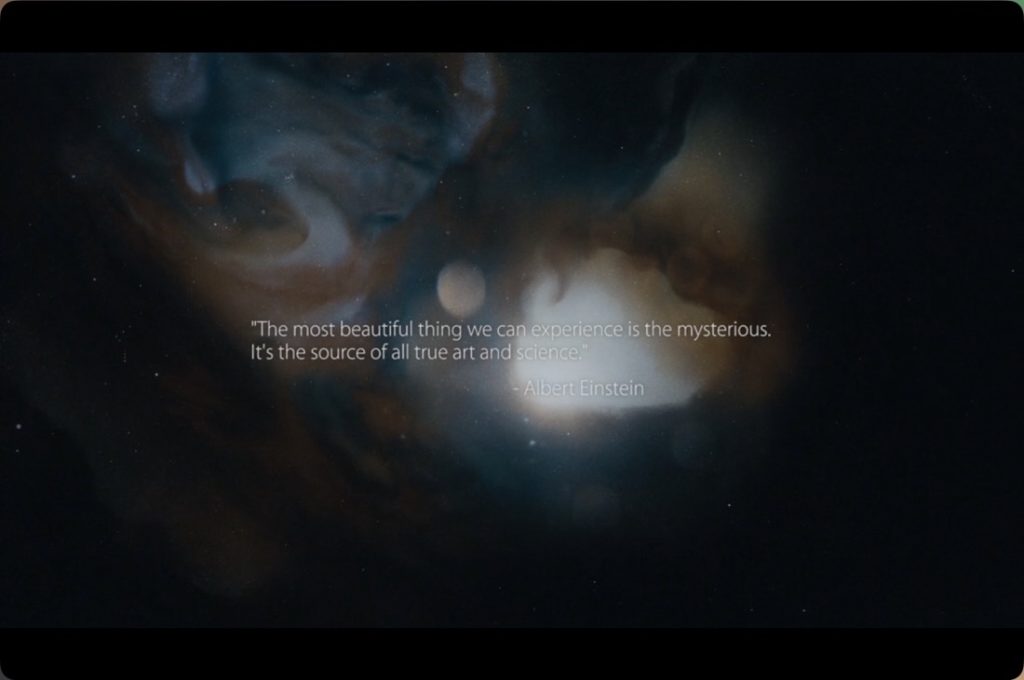
To go along with the short film, Apple has created a new featured section on Apple Music called “Destination: Jupiter” that highlights the short film as well as the music that appears in it. I’ve not yet listened but it includes tracks by Trent Reznor, Corinne Bailey Rae, and Quin. The film not only includes live music by the above artists but also an interview with Juno principal investigator Scott Bolton.
NASA missions into the solar system are always exciting. Years of planning followed by years in space and then months to years of data collection. Juno, launched in August 2011, will have been traveling just shy of five years when it enters a polar orbit on July 4.
The spacecraft is to be placed in a polar orbit to study Jupiter's composition, gravity field, magnetic field, and polar magnetosphere. Juno will also search for clues about how the planet formed, including whether it has a rocky core, the amount of water present within the deep atmosphere, mass distribution, and its deep winds, which can reach speeds of 618 kilometers per hour (384 mph).
According to Apple the goal of its partnership with NASA is to educate and inspire people, while also highlighting the link between exploring space and making music. From USA Today: “The goal is to make science and technology more accessible and relatable to everyone.” - Apple vice-president Robert Kondrk. For those that might ask, what’s the connection between space exploration and creative expression? I would answer that there’s nothing we might do that requires the imagination and creativity like space exploration does. Science, in a general way, is often rooted in a creative process. Much of what Einstein accomplished had it’s origins in creative thought experiments in which he imagined different scenarios so that he might work through. And he isn’t the only one to have used such thought experiments! Spend some time browsing around the fantastic NASA website, have a look at the many ongoing missions and past missions and consider the beautiful dance of science and creativity that goes into the designing of our space telescopes, rovers, and orbiters. NASA often exhibits the best of humanity. Okay, now I’m gushing. This is what happens when I’m allowed at the keyboard unsupervised while on the topic of NASA.
Also, in case you missed it, one last bit of NASA news. Earlier this month, NASA released an application for iOS and the fourth-gen Apple TV. The app includes live streaming NASA TV, a real-time view of the Earth from the International Space Station, as well as on-demand access to over 10,000 NASA videos and more than 15,000 photos, either individually or as a slideshow. It’s a fantastic tool for exploring our solar system from the comfort of your couch. From your Apple TV search for NASA in the App Store. Or, from your iOS device get it from the iTunes App Store.
To view the new Apple Music/NASA short film, head to Apple Music.
Vulnerability, change and growth
Yes, yes, I know. I’ve brought up the recent ending/change of my recent relationship with Kaleesha a lot recently. It figures in. Much of what I’m thinking about at the moment is where I went with that relationship and what it means for me. In the spring of 2013 I hadn’t really been looking for a relationship. I mean, I was open to that sort of thing but I don’t recall it being a high priority at any point in the years since I left Memphis. I’d settled into something fairly comfortable for myself. And yet, here was a new friendship that seemed to be evolving into something more. As much as I was comfortable with my life I’m also someone that rolls with life. I kinda jumped in. I didn’t know there it would lead but I thought it would be worth the risk. She is a wonderful and lovely person as are her seven wee people.
Vulnerability. You see, when we decided I would move in, that we would have a go at a partnership, well, at that point it was no longer just about connecting and growing with Kaleesha, but also about connecting and growing with her seven children. Many years ago I’d made a decision to never have children.. My decision to not have children was not based on a dislike of kids or an aversion to the idea of being a parent. In fact, I’d always thought I would make a good dad, a good parent. My decision was based on my belief that the planet already had too many humans, many of which are living without much thought for the future. It’s a natural part of being a human animal to want to procreate but for me it was a sacrifice worth making. Having children didn’t seem fair or responsible to them or to the other species on the planet. In any case, it was a decision I stuck with but I always wondered about how it would have gone for me in that role. In the short time I lived at Make-it-Do Farm my thoughts about my ability and desire to parent were, for the most part, confirmed. Well, it really was fairly early in the process when it ended but it was going pretty well.
But of course, I wasn’t really prepared for it. My skin was too thin. I had (have) much to learn about loving unconditionally. I suspect that parents, biological parents, have an opportunity to grow into that relationship, into that kind of giving. That’s probably obvious. But for someone who’s never had kids, well, there is no slow evolution. It’s all a bit more abrupt. One does not move in with a woman with seven kids without a certain willingness, a certain commitment to stretching and growing, to being a responsible adult. As well as a certain willingness to being hurt.
But for me, in the context of my move into Kaleesha and the kids’ lives, vulnerability was not just about the process of parenting, not just about the process of learning to love children not my own, but ultimately also about loosing them. I could not be certain that Kaleesha and I would last though I thought we would. I wouldn’t have moved in if I had thought otherwise. But I knew I was putting myself in a position in which I might end up hurting. But that’s life. It’s a risky adventure sometimes.
There’s an openness that comes with connecting with the life around us. It often means pain, real pain because, frankly, we live in a world full of pain. Suffering is everywhere. Injustice is everywhere. I find it overwhelming at times and yet I keep breathing. We may well be in the middle of the 6th great extinction and yet, there is only so much I can do. Only so much any one of us can do. So, sometimes I’ll cry. Other times I’ll laugh. Mostly I’ll try to breath in and take it all one step at a time.
So I took a risk, I had an adventure and now I transition back into my old life. But it’s not my old life, it’s something new in the space I lived in before because I’m no longer the Denny that left his cabin and his garden in the spring of 2013. Just as I’m not the Denny of 2008 that built the cabin. Or the Denny that left Memphis over a decade ago. Life experience changes us. That’s obvious but I think sometimes we forget to pay attention to the process.
I find myself feeling a bit more confused than usual about what I want, about who I want to be. In particular, I feel an inclination to retreat for a while. To take some time from human company. And yet, there is a part of me that is inclined to reach out and connect. A part of what makes it confusing for me is the possibility that I might be acting, or, more to the point, reacting, to being on my own again. It’s a strange thing to not know your own mind, your own intentions. I suppose, for the moment, there’s not much to be done for it. I’m okay with not knowing. It’s interesting to wonder how much of who we are is our intent. I speak of my mind as though it is something to be discovered, as though I do not control it, and often it seems that way. Which leads me to ask, is the mind beyond our control? Just something we partially control. Or is any control just an illusion. Ha. Time to visit Wikipedia. This is something that’s been discussed and studied. And there are no clear answers. I suppose this falls within the “mind-body problem”. Fun fun. Maybe time to add neuroscience to my list of studies?
So, there are no easy answers. Guess for now I’ll keep getting up every day. I’ll drink my coffee, walk the dog, read, work, listen to the frogs and see how things go.
Gravitational Waves Discovered
In case you missed it: LIGO announced the detection of Gravitational Waves
For the first time, scientists have observed ripples in the fabric of spacetime called gravitational waves. This confirms a major prediction of Albert Einstein’s 1915 general theory of relativity and opens an unprecedented window onto the cosmos.A lot more at LIGO’s Detection Portal.
Gravitational waves were detected by the two LIGO detectors in Hanford, Washington and Livingston, Louisiana, United States, at 5:51 am EDT (0951 UTC). The waves were generated during the final moments of the merger of 2 black holes resulting in a single, massive, rotating black hole. Even though such a merger was predicted to happen, it was never observed before.
The merger of the two black holes happened more than 1 billion light-years away. (definition of a light-year, use this calculator to convert light-years to miles.)
Why is this discovery so important? Gravitational waves tell us a lot about their cataclysmic origins. They offer a unique way to look deep into the past and observe cosmic events that happened a very long time ago. Gravitational waves provide information about the nature of gravity that we wouldn’t be able to get any other way. With this observation, LIGO opens a new window through which we can study the cosmos.
Getting lost in NASA - The Curiosity Rover has a Chemcam Blog
The NASA website is an amazingly deep rabbit hole. It is it’s own internet. Really, between Wikipedia and NASA, I can and often do go days without seeing the rest of the interwebs. Here’s just one tiny corner of just one of many sections of the site: The Curiosity Rover Chemcam Blog
Never heard of the Chemcam? Basically it is a camera/laser combo that takes high resolution images and vaporizes rocks with a laser and analyzes the resulting light to determine the chemical make-up of the rock. More via the Wikipedia page for Chemcam:
Chemistry and Camera complex (ChemCam) is a suite of remote sensing instruments on Mars for the Curiosity rover. As the name implies, ChemCam is actually two different instruments combined as one: a laser-induced breakdown spectroscopy (LIBS) and a Remote Micro Imager (RMI) telescope. The purpose of the LIBS instrument is to provide elemental compositions of rock and soil, while the RMI will give ChemCam scientists high-resolution images of the sampling areas of the rocks and soil that LIBS targets. The LIBS instrument can target a rock or soil sample from up to 7 m (23 ft) away, vaporizing a small amount of it with about 50 to 75 5-nanosecond pulses from a 1067 nm infrared laser and then observing the spectrum of the light emitted by the vaporized rock.The Chemcam is just one of many instruments carried by the Curiosity Rover.
Space Exploration Themed Posters Part Two
I continue to enjoy Affinity Designer. In fact, after three months of use I far prefer it (as well as Affinity Photo) to Illustrator or Photoshop. As of this moment my plan is to only use the Adobe apps if a client/project requires it. These new Affinity apps by Serif are fantastic and did I mention they are not rented via subscription but available for purchase the old-fashioned way? Buttery smooth, fully featured and a pleasure to use.
In my downtime this summer I’ve continued working on my series of space exploration-themed posters which I’ve made available on Red Bubble.
[caption id=“attachment_486” align=“aligncenter” width=“625”]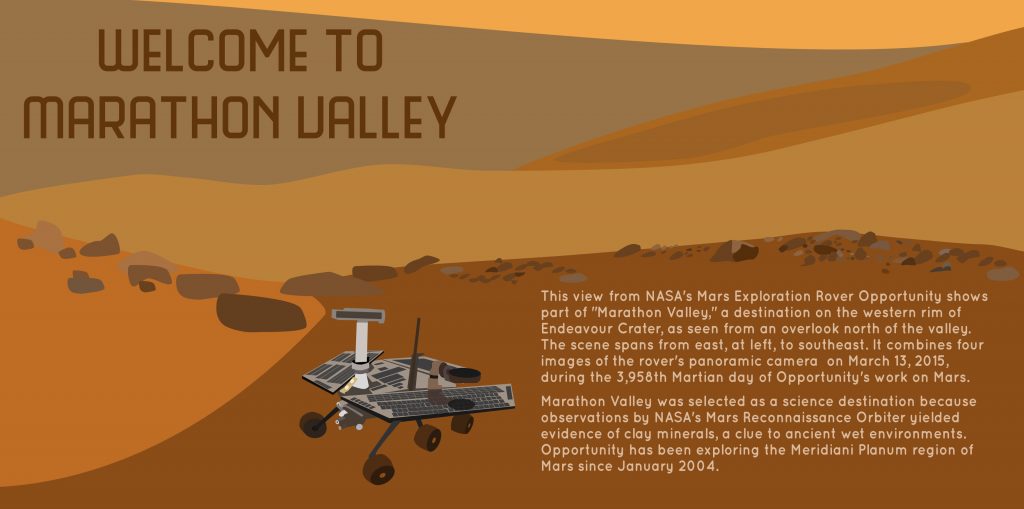 Marathon Valley Overlook[/caption]
Marathon Valley Overlook[/caption]
This view from NASA’s Mars Exploration Rover Opportunity shows part of “Marathon Valley,” a destination on the western rim of Endeavour Crater, as seen from an overlook north of the valley. The scene spans from east, at left, to southeast. It combines four images of the rover’s panoramic camera on March 13, 2015, during the 3,958th Martian day of Opportunity’s work on Mars.
Marathon Valley was selected as a science destination because observations by NASA’s Mars Reconnaissance Orbiter yielded evidence of clay minerals, a clue to ancient wet environments. Opportunity has been exploring the Meridiani Planum region of Mars since January 2004.
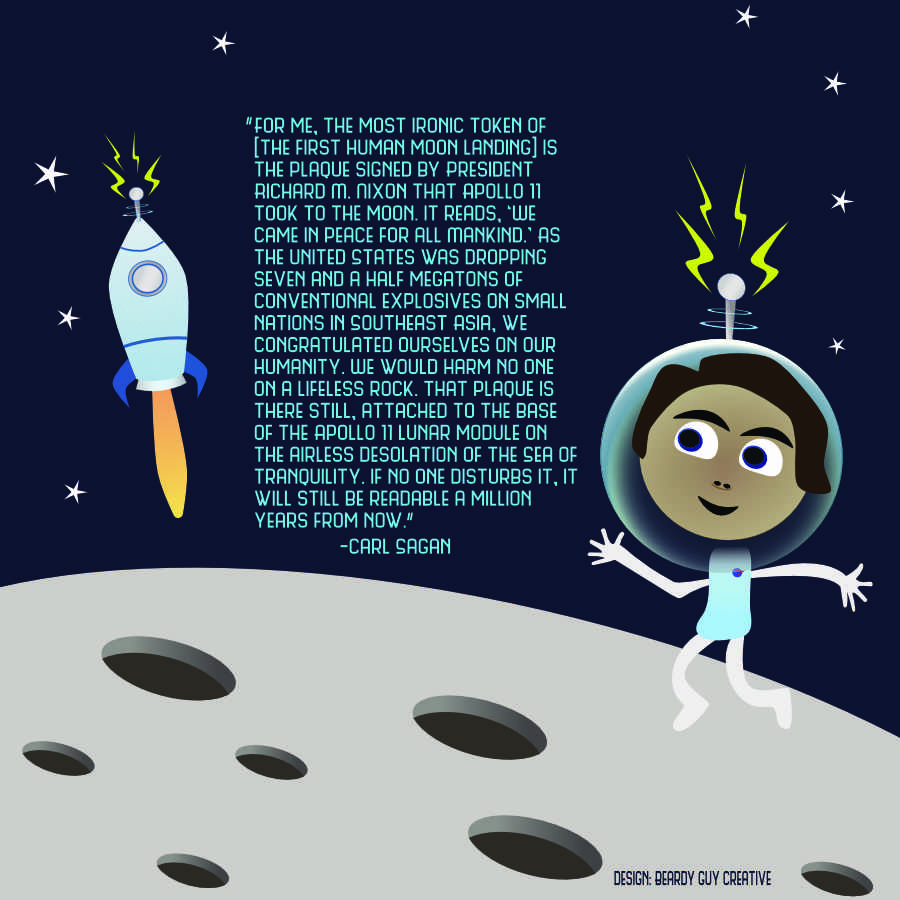
“For me, the most ironic token of [the first human moon landing] is the plaque signed by President Richard M. Nixon that Apollo 11 took to the moon. It reads, ‘We came in peace for all Mankind.’ As the United States was dropping seven and a half megatons of conventional explosives on small nations in Southeast Asia, we congratulated ourselves on our humanity. We would harm no one on a lifeless rock. That plaque is there still, attached to the base of the Apollo 11 lunar module on the airless desolation of the Sea of Tranquility. If no one disturbs it, it will still be readable a million years from now.” -Carl Sagan
Space Exploration Themed Posters
My trial run with Affinity Design continues, this time with a series of space exploration posters featuring Carl Sagan quotes.
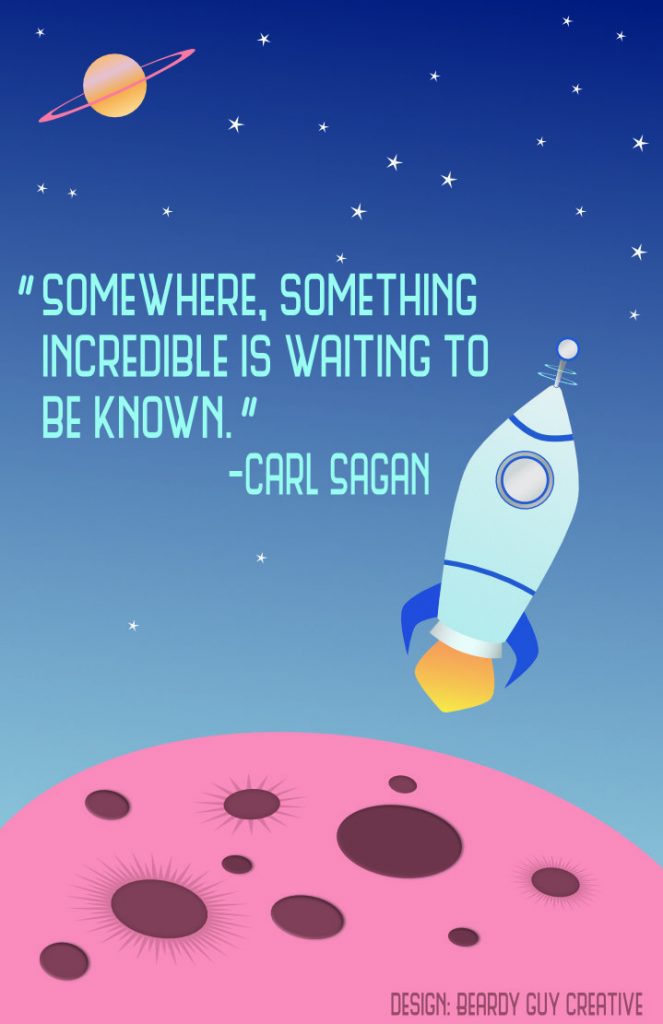
“Somewhere, something incredible is waiting to be known.” - Carl Sagan
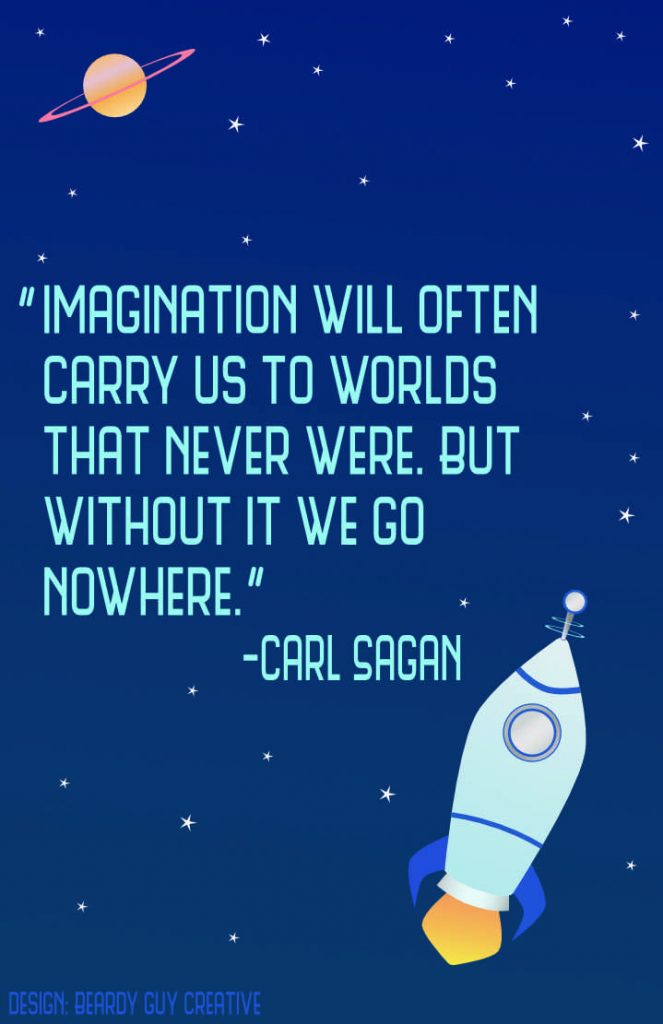
“Imagination will often carry us to worlds that never were. But without it we go nowhere.” - Carl Sagan
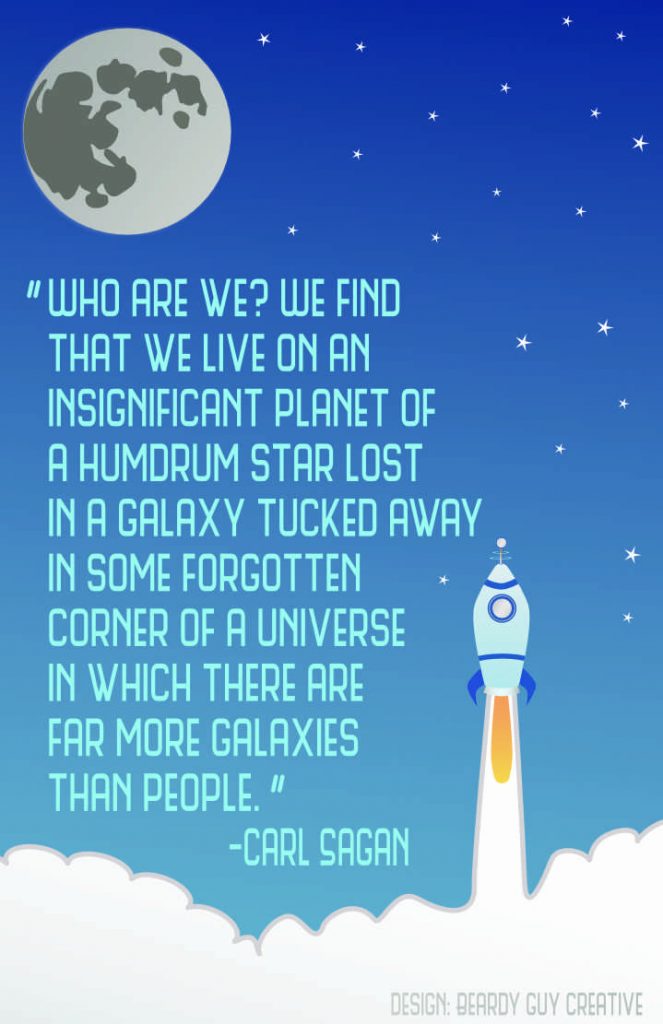
“Who are we? We find that we live on an insignificant planet of a humdrum star lost in a galaxy tucked away in some forgotten corner of a universe in which there are far more galaxies than people.” - Carl Sagan
Busy Spring!
Spring has come to Missouri and with it lots of work for Tucker Creek Creative as well as plenty of work for us at Make-it-Do Farm. As if my freelance work and our farm/garden projects weren’t enough, we’ve also been busy with activities for the kids. Mainly we’ve discovered Farmington-based Lab Revolution which is a technology-based 4-H group. We’ve had fantastic fun thus far.
Check the links above to Kaleesha’s great posts providing all the details and lots of great photos!
It Could Happen
Colin Dickey writing for Aeon on why it’s dangerous for modern civilization to be so dependent on technology:
On 1 September 1859, the British astronomer Richard Carrington witnessed a Coronal Mass Ejection (CME), a burst of solar winds and magnetic energy that had escaped the corona of the Sun. The Carrington Event, as it came to be known, was not only the first recorded CME, it was also one of the largest ever on record, and it unleashed a foreboding and wondrous display of light and magnetic effects. Auroras were seen as far south in the northern hemisphere as San Salvador and Honolulu. As the Baltimore Sun reported at the time: ‘From twilight until 10 o’clock last night the whole heavens were lighted by the aurora borealis, more brilliant and beautiful than had been witnessed for years before.’
At the time, the event caused some minor magnetic disruption to telegraph wires, but for the most part there was little damage caused by such a spectacular event, its main legacy being the fantastic displays of light across the sky in early September. But should a solar flare happen on the scale of the Carrington Event now (and there’s a 12 per cent chance of one hitting the Earth before 2022), the effects might have a radically different impact on our advanced civilisation. If a CME with the same intensity were to hit the Earth head-on, it could cause catastrophic damage.
A National Research Council report in 2008 estimated that another Carrington Event could lead to a disruption of US infrastructure that could take between four and 10 years – and trillions of dollars – to recover from. Particularly vulnerable are the massive transformers on which our entire power system relies. Massive fluxes in magnetic energy can easily overload a transformer’s magnetic core, leading to overheating and melting of their copper cores. In the worst-case scenario, a repeat of the Carrington Event would cripple our infrastructure so severely it could lead to an apocalyptic breakdown of society, a threat utterly unknown to our ‘less civilised’ ancestors.
Illustration: Common Components of Vaccines
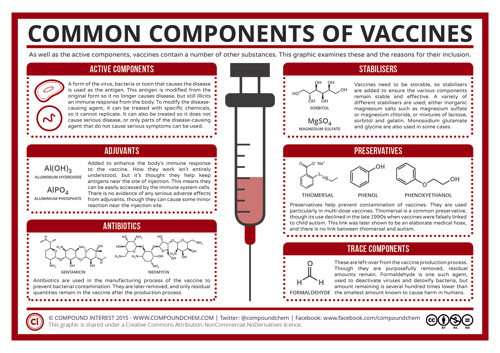 From the excellent Compound Interest, a website all about Chemistry, is this post regarding the common components of vaccines.
From the excellent Compound Interest, a website all about Chemistry, is this post regarding the common components of vaccines.
The recent measles outbreak in the US has once again provoked discussion over vaccinations, and why some parents choose not to vaccinate their children despite the benefits of doing so. Whilst not the only factor, part of the blame lies with misinformation about the chemical composition of vaccines and the effects these compounds can have. This graphic summarises some of the key components in vaccines, as well as clarifying their purpose and safety in the concentrations present.
A Rough Guide to Spotting Bad Science
The vast majority of people will get their science news from online news site articles, and rarely delve into the research that the article is based on. Personally, I think it’s therefore important that people are capable of spotting bad scientific methods, or realising when articles are being economical with the conclusions drawn from research, and that’s what this graphic aims to do. Note that this is not a comprehensive overview, nor is it implied that the presence of one of the points noted automatically means that the research should be disregarded. This is merely intended to provide a rough guide to things to be alert to when either reading science articles or evaluating research.
Concerning the feelings of anti-vaxxers
Robert Moore on the respect anti-vaxxers deserve
A post about your feelings…
So, I’ve been seeing a lot of ‘I’m sorry for hurting your feelings posts’ with regards to vaccines, and I thought I’d make it clear that I’m absolutely, in no way, at all, sorry for hurting any of your feelings if you’re anti vaccination and not telling me.
You deserve to have your feelings hurt.
Your opinion, which you are absolutely entitled to, hurts children. It kills children. So I’m entitled to also have an opinion about you and your poor decision making. I’m entitled to mock you openly when I watch a video of an infant with whooping cough. Because without your beliefs on vaccines today there would be no whooping cough.
Agreed.
Particle Fever
This is a fantastic movie. Imagine a documentary about particle physics that might bring you to tears. So beautiful. The movie documents the CERN particle collider and the search for the Higgs Boson. It illustrates the basic physics that are being studied even as it explores the humanity of some of the scientists that are involved. The art and illustration used to explain the science is very well done. All of it very accessible to anyone regardless of science background. Purchase from iTunes or stream it from the website.


